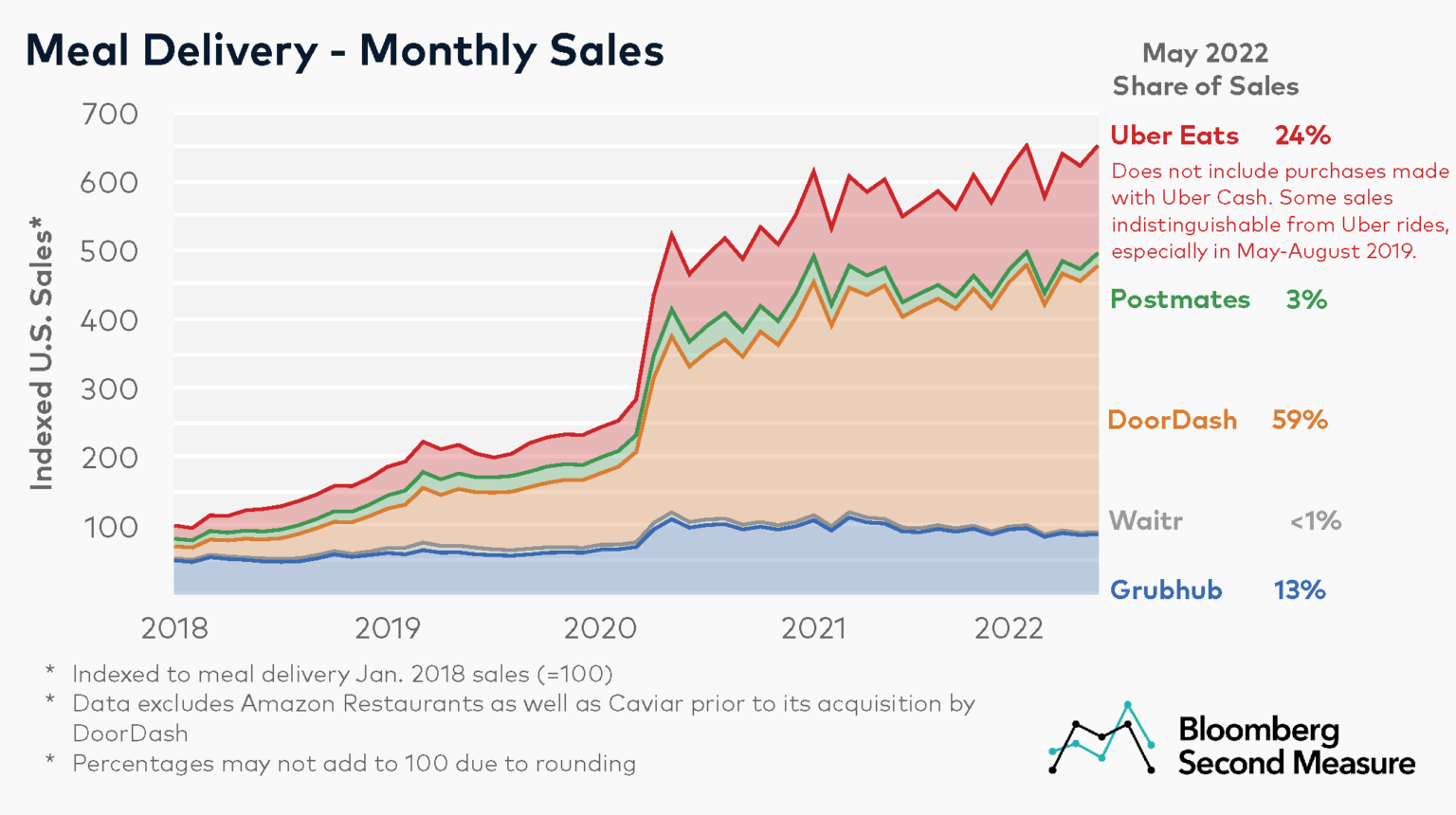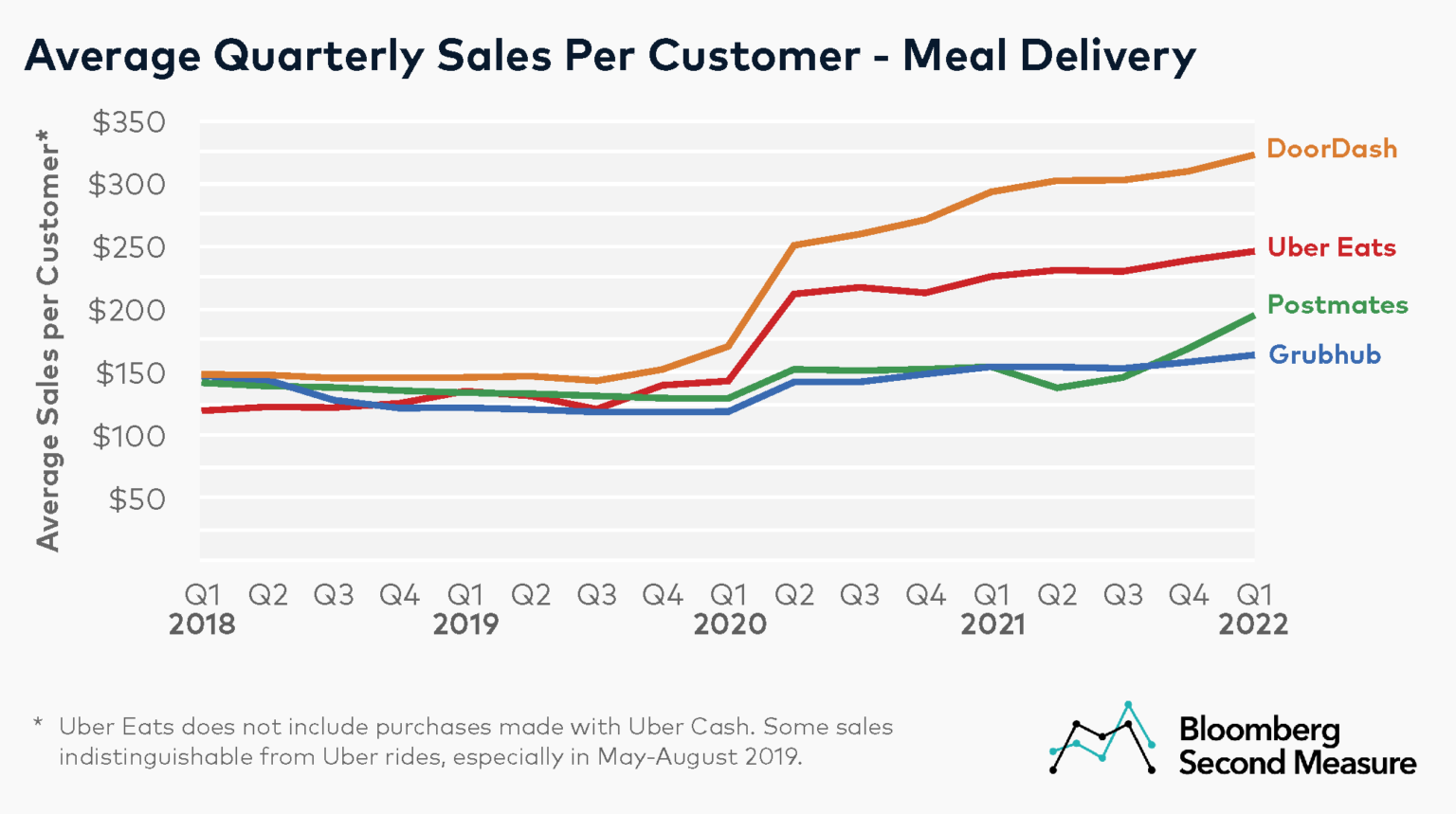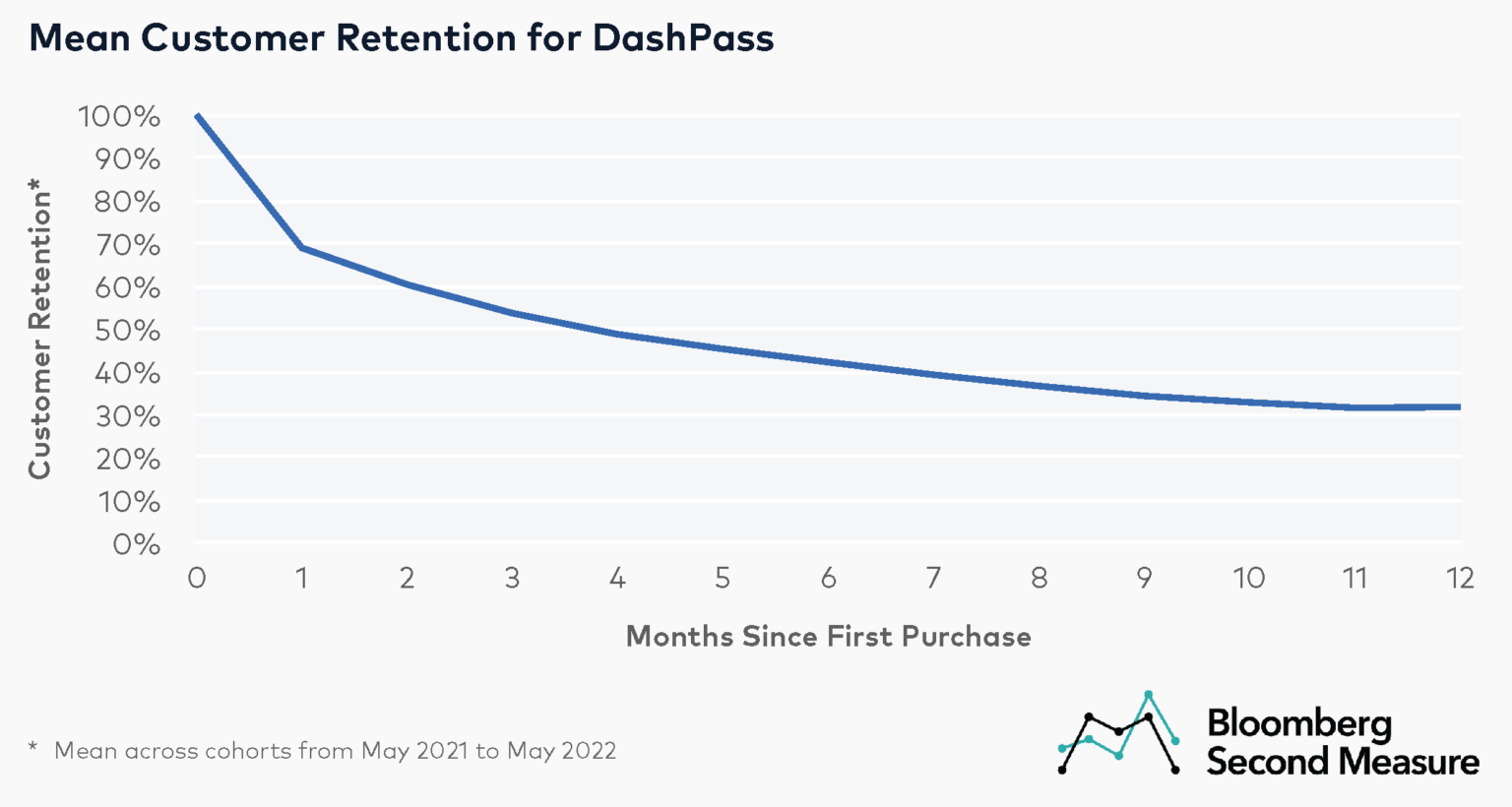
Source: https://secondmeasure.com/datapoints/food-delivery-services-grubhub-uber-eats-doordash-postmates/
When many Americans sheltered in their homes early in the coronavirus pandemic, meal delivery sales reached new heights. Our data reveals that in May 2022, sales for meal delivery services grew 8 percent year-over-year, collectively.

These thriving businesses have been in the spotlight during the COVID-19 era. DoorDash (NYSE: DASH) made its public market debut with one of the biggest IPOs of 2020, while Uber (NYSE: UBER) acquired Postmates at the end of November 2020 in an attempt to consolidate market share and boost profitability. Uber is also seeking ways to diversify its existing business, such as by launching a U.S. grocery delivery service and piloting same-day delivery with Costco. Uber has also expanded its prescription delivery partnership with Nimble and acquired alcohol delivery company Drizly. Meanwhile, DoorDash has partnerships with CVS as well as regional and national convenience stores for the delivery of household essentials. DoorDash also partnered with Albertsons to expand its grocery delivery offerings and reportedly engaged in talks to buy Instacart. In September 2021, DoorDash also announced that it was adding alcohol delivery to its app. Both Uber Eats and DoorDash have also recently launched nationwide shipping from select merchants.
Bloomberg Second Measure’s transaction data shows that DoorDash and its subsidiaries earned 59 percent of U.S. consumers’ meal delivery sales in May 2022, while Uber Eats came in second place with 24 percent. It’s worth noting that our sales metrics may differ from publicly reported earnings for a number of reasons. First, some Uber Eats transactions are indistinguishable from Uber Rides transactions in Bloomberg Second Measure’s data, and this issue was especially pronounced from May 2019 to mid-August 2019. Additionally, Bloomberg Second Measure’s data does not include Uber Eats’ purchases made using Uber Cash or purchases made by corporate customers, an area where Uber Eats is reportedly making inroads. Our analysis includes debit and credit card purchases from a panel of millions of U.S. consumers. Postmates earned 3 percent of the U.S. meal delivery market in May 2022, bringing Uber’s total market share to 27 percent.
Grubhub and its subsidiaries, which include Seamless and Eat24, came in at 13 percent of U.S. meal delivery consumer spending in May 2022. (Purchases made through LevelUp, which Grubhub acquired in late 2018, are not included in our analysis. Neither are college student meal plan purchases made through Grubhub subsidiary Tapingo.)
One of the industry’s smaller services, Waitr (NASDAQ: WTRH), earned less than 1 percent of national sales in May 2022. In January 2020, the company announced plans to lay off all drivers in favor of using contractors. The change came weeks after Waitr installed a new CEO as it tried to boost share prices and remain listed on Nasdaq. In December 2021, Waitr also announced its plans to acquire the cannabis dispensary POS platform Cova.
Average sales per customer on the rise at meal delivery companies, especially DoorDash and Uber Eats
In addition to more consumers ordering from food delivery services, the average sales per customer has increased at these companies during the pandemic. DoorDash and Uber Eats have seen the most growth in average sales per customer over the past two years. At DoorDash, the average sales per customer in the first quarter of 2022 was 89 percent higher than in the first quarter of 2020. For Uber Eats, the average sales per customer rose 72 percent during the same time period.

In the first quarter of 2022, DoorDash customers spent the most, with an average of $323 per customer. Uber Eats’ quarterly customer spend was the second highest with an average of $246, while customers at Postmates and Grubhub spent an average of $195 and $163, respectively.
Consumers may be paying even more for meal delivery services in the near future, as the price of food and gas continue to rise. Meal delivery companies have responded to these inflationary pressures in different ways. For example, Uber Eats implemented a fuel surcharge for consumers, starting in March 2022. DoorDash launched a gas rewards program for drivers to aid with rising fuel costs, while Grubhub has boosted driver pay per mile.
Subscription meals have appeal
As meal delivery services look for new ways to grow in cities big and small, one emerging answer is subscriptions. Postmates launched Postmates Unlimited in 2016, while DoorDash and Grubhub followed suit with their own subscription options in 2018 and 2020, respectively. In November 2021, Uber also launched its new “Uber One” subscription plan, which offers benefits for both rides and delivery services.
In May 2022, DoorDash’s DashPass subscription attracted 30 percent of DoorDash’s customers. Among cohorts who signed up for DashPass between May 2021 and May 2022, an average of 69 percent remained subscribed after one month. The average six-month customer retention rate for DashPass was 42 percent and the average 12-month retention rate was 32 percent. In April 2022, DoorDash also launched DashPass for Students, which offers the subscription’s benefits at a reduced price.

Notably, in December 2019, DoorDash also partnered with Chase to give free DashPass memberships to millions of credit card holders. These free memberships are not included in Bloomberg Second Measure’s data.
Companies vie for restaurant partners
Another very popular growth strategy for meal delivery companies has been forming partnerships with the nation’s top chain restaurants. (Though many services have also been in the news for listing restaurants that do not want partnerships.) In 2020, DoorDash officially teamed up with Little Caesars Pizza, a brand that has never previously offered delivery. DoorDash has other deals with Wendy’s, Chick-fil-A, and McDonald’s, the biggest fast food chain in the country, which also offers delivery with Uber Eats.
Starbucks has a contract with Uber Eats, Popeyes with Postmates, and Taco Bell and KFC with Grubhub. Yet, as Uber Eats and Grubhub public filings show, partnerships don’t always lead to revenue. Often, larger partners pay the delivery services lower fees, decreasing their take rates or even causing them to lose money. Conversely, some restaurants that are relying heavily on delivery amidst the COVID-19 pandemic have reported losing money on orders as meal delivery companies charge high service fees, prompting policy intervention in many cities. New York City has also recently passed legislation to improve conditions for food delivery workers.
However, the partnerships seem to be driving sales for some of the restaurants. The Cheesecake Factory and Chipotle have publicly credited DoorDash with boosting their revenue. In May 2022, DoorDash accounted for 8 percent of sales at Buffalo Wild Wings and 11 percent at Chipotle (before subtracting DoorDash’s cut or the delivery tip).
Fewer customers are loyal to a single meal delivery service
Despite overall industry growth, the battle for customers is getting more intense because fewer of today’s diners are loyal to just one service. (Grubhub’s former CEO cited “promiscuous customers” as a hindrance to his company’s growth.) As more restaurants form exclusive delivery partnerships, more diners are going to have to hop between apps to cover all their favorite takeout spots. The least loyal customers, it seems, will also be the most well fed.
To learn more about the data behind this article and what Second Measure has to offer, visit https://secondmeasure.com/.







Sign up to receive our stories in your inbox.
Data is changing the speed of business. Investors, Corporations, and Governments are buying new, differentiated data to gain visibility make better decisions. Don't fall behind. Let us help.













Sign up to receive our stories in your inbox.
Data is changing the speed of business. Investors, Corporations, and Governments are buying new, differentiated data to gain visibility make better decisions. Don't fall behind. Let us help.





